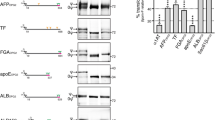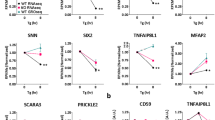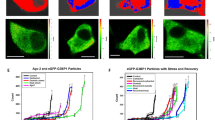Abstract
The unfolded protein response (UPR), caused by stress, matches the folding capacity of endoplasmic reticulum (ER) to the load of client proteins in the organelle1,2. In yeast, processing of HAC1 mRNA by activated Ire1 leads to synthesis of the transcription factor Hac1 and activation of the UPR3. The responses to activated IRE1 in metazoans are less well understood. Here we demonstrate that mutations in either ire-1 or the transcription-factor-encoding xbp-1 gene abolished the UPR in Caenorhabditis elegans. Mammalian XBP-1 is essential for immunoglobulin secretion and development of plasma cells4, and high levels of XBP-1 messenger RNA are found in specialized secretory cells5. Activation of the UPR causes IRE1-dependent splicing of a small intron from the XBP-1 mRNA both in C. elegans and mice. The protein encoded by the processed murine XBP-1 mRNA accumulated during the UPR, whereas the protein encoded by unprocessed mRNA did not. Purified mouse IRE1 accurately cleaved XBP-1 mRNA in vitro, indicating that XBP-1 mRNA is a direct target of IRE1 endonucleolytic activity. Our findings suggest that physiological ER load regulates a developmental decision in higher eukaryotes.
This is a preview of subscription content, access via your institution
Access options
Subscribe to this journal
Receive 51 print issues and online access
$199.00 per year
only $3.90 per issue
Buy this article
- Purchase on Springer Link
- Instant access to full article PDF
Prices may be subject to local taxes which are calculated during checkout




Similar content being viewed by others
References
Mori, K. Tripartite management of unfolded proteins in the endoplasmic reticulum. Cell 101, 451–454 (2000).
Kaufman, R. J. Stress signaling from the lumen of the endoplasmic reticulum: coordination of gene transcriptional and translational controls. Genes Dev. 13, 1211–1233 (1999).
Shamu, C. E. Splicing: HACking into the unfolded-protein response. Curr. Biol. 8, R121–R123 (1998).
Reimold, A. M. et al. Plasma cell differentiation requires the transcription factor XBP-1. Nature 412, 300–307 (2001).
Clauss, I. M. et al. In situ hybridization studies suggest a role for the basic region-leucine zipper protein hXBP-1 in exocrine gland and skeletal development during mouse embryogenesis. Dev. Dyn. 197, 146–156 (1993).
Travers, K. J. et al. Functional and genomic analyses reveal an essential coordination between the unfolded protein response and ER-associated degradation. Cell 101, 249–258 (2000).
Casagrande, R. et al. Degradation of proteins from the ER of S. cerevisiae requires an intact unfolded protein response pathway. Mol. Cell 5, 729–735 (2000).
Scheuner, D. et al. Translational control is required for the unfolded protein response and in vivo glucose homeostasis. Mol. Cell 7, 1165–1176 (2001).
Harding, H. et al. Regulated translation initiation controls stress-induced gene expression in mammalian cells. Mol. Cell 6, 1099–1108 (2000).
Yoshida, H. et al. ATF6 activated by proteolysis binds in the presence of NF-Y (CBF) directly to the cis-acting element responsible for the mammalian unfolded protein response. Mol. Cell Biol. 20, 6755–6767 (2000).
Ye, J. et al. ER stress induces cleavage of membrane-bound ATF6 by the same proteases that process SREBPs. Mol. Cell 6, 1355–1364 (2000).
Urano, F. et al. Coupling of stress in the endoplasmic reticulum to activation of JNK protein kinases by transmembrane protein kinase IRE1. Science 287, 664–666 (2000).
Yoshida, H., Haze, K., Yanagi, H., Yura, T. & Mori, K. Identification of the cis-acting endoplasmic reticulum stress response element responsible for transcriptional induction of mammalian glucose-regulated proteins. Involvement of basic leucine zipper transcription factors. J. Biol. Chem. 273, 33741–33749 (1998).
Tirasophon, W., Welihinda, A. A. & Kaufman, R. J. A stress response pathway from the endoplasmic reticulum to the nucleus requires a novel bifunctional protein kinase/endoribonuclease (Ire1p) in mammalian cells. Genes Dev. 12, 1812–1824 (1998).
Bertolotti, A. et al. Increased sensitivity to dextran sodium sulfate colitis in IRE1b deficient mice. J. Clin. Invest. 107, 585–593 (2001).
Wang, X. Z. et al. Cloning of mammalian Ire1 reveals diversity in the ER stress responses. EMBO J. 17, 5708–5717 (1998).
Gonzalez, T. N., Sidrauski, C., Dorfler, S. & Walter, P. Mechanism of non-spliceosomal mRNA splicing in the unfolded protein response pathway. EMBO J. 18, 3119–3132 (1999).
Kawahara, T., Yanagi, H., Yura, T. & Mori, K. Unconventional splicing of HAC1/ERN4 mRNA required for the unfolded protein response. Sequence-specific and non-sequential cleavage of the splice sites. J. Biol. Chem. 273, 1802–1807 (1998).
Clark, S. G., Lu, X. & Horvitz, H. R. The Caenorhabditis elegans locus lin-15, a negative regulator of a tyrosine kinase signaling pathway, encodes two different proteins. Genetics 137, 987–997 (1994).
Fire, A. et al. Potent and specific genetic interference by double-stranded RNA in Caenorhabditis elegans. Nature 391, 806–811 (1998).
Niwa, M., Sidrauski, C., Kaufman, R. J. & Walter, P. A role for presenilin-1 in nuclear accumulation of Ire1 fragments and induction of the mammalian unfolded protein response. Cell 99, 691–702 (1999).
Acknowledgements
We thank C. Chiu for help in initiating the nematode work; A. Bertolotti, D. Levy and E. Y. Skolnik for useful discussions; Y. Kohara for C. elegans EST clones; and A. Ron and R. Onn for calculating the synthesis rate of XBP1 proteins. This work was supported by grants from the National Institutes of Health. D.R. is a Scholar of the Ellison Medical Foundation.
Author information
Authors and Affiliations
Corresponding author
Ethics declarations
Competing interests
The authors declare no competing financial interests.
Supplementary information
Rights and permissions
About this article
Cite this article
Calfon, M., Zeng, H., Urano, F. et al. IRE1 couples endoplasmic reticulum load to secretory capacity by processing the XBP-1 mRNA. Nature 415, 92–96 (2002). https://doi.org/10.1038/415092a
Received:
Accepted:
Issue Date:
DOI: https://doi.org/10.1038/415092a
This article is cited by
-
The emerging roles of sphingosine 1-phosphate and SphK1 in cancer resistance: a promising therapeutic target
Cancer Cell International (2024)
-
Endoplasmic reticulum stress and the unfolded protein response: emerging regulators in progression of traumatic brain injury
Cell Death & Disease (2024)
-
Targeting the IRE1α-XBP1s axis confers selective vulnerability in hepatocellular carcinoma with activated Wnt signaling
Oncogene (2024)
-
UBXN1 maintains ER proteostasis and represses UPR activation by modulating translation
EMBO Reports (2024)
-
Protein secretion and associated stress in industrially employed filamentous fungi
Applied Microbiology and Biotechnology (2024)
Comments
By submitting a comment you agree to abide by our Terms and Community Guidelines. If you find something abusive or that does not comply with our terms or guidelines please flag it as inappropriate.



